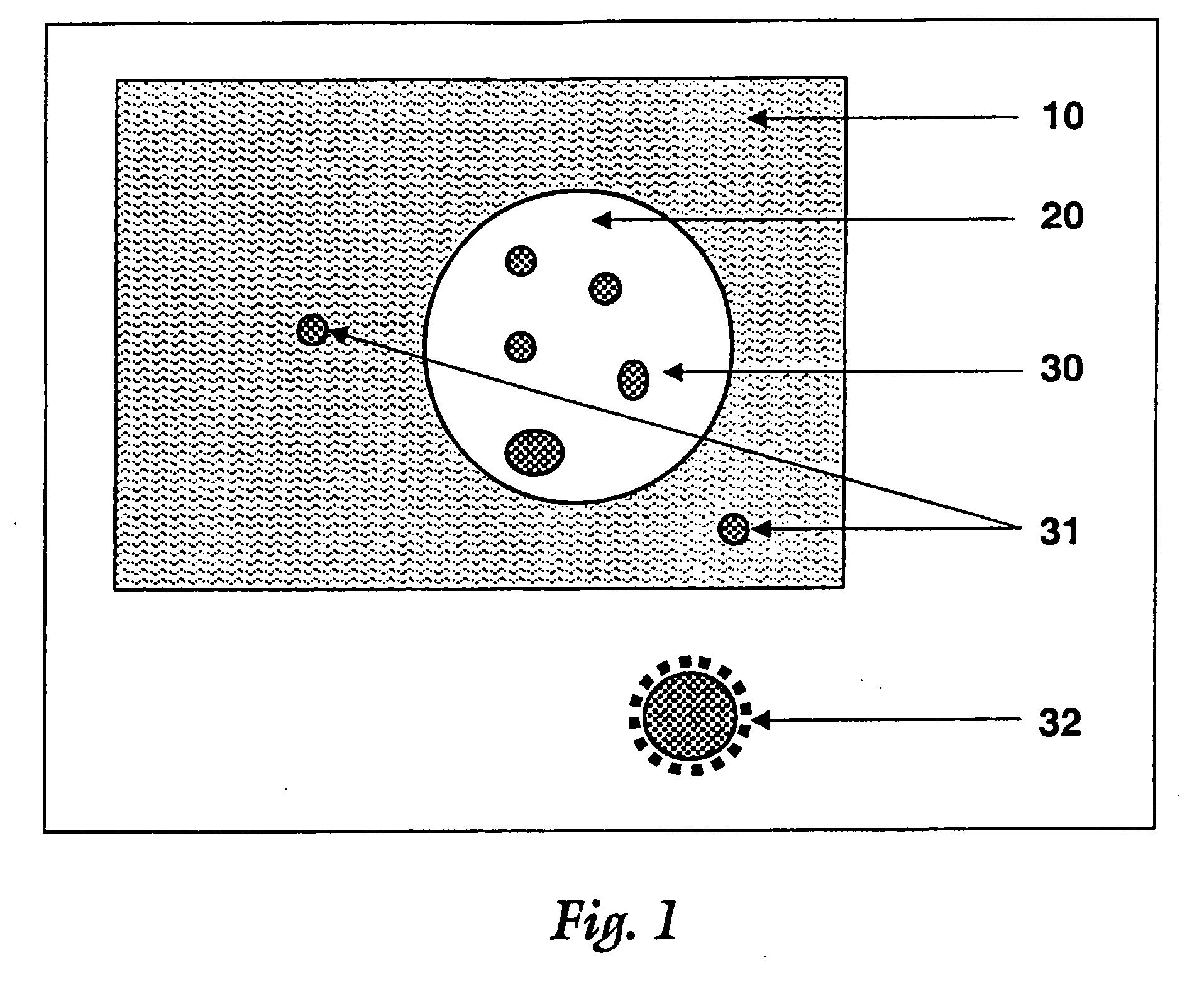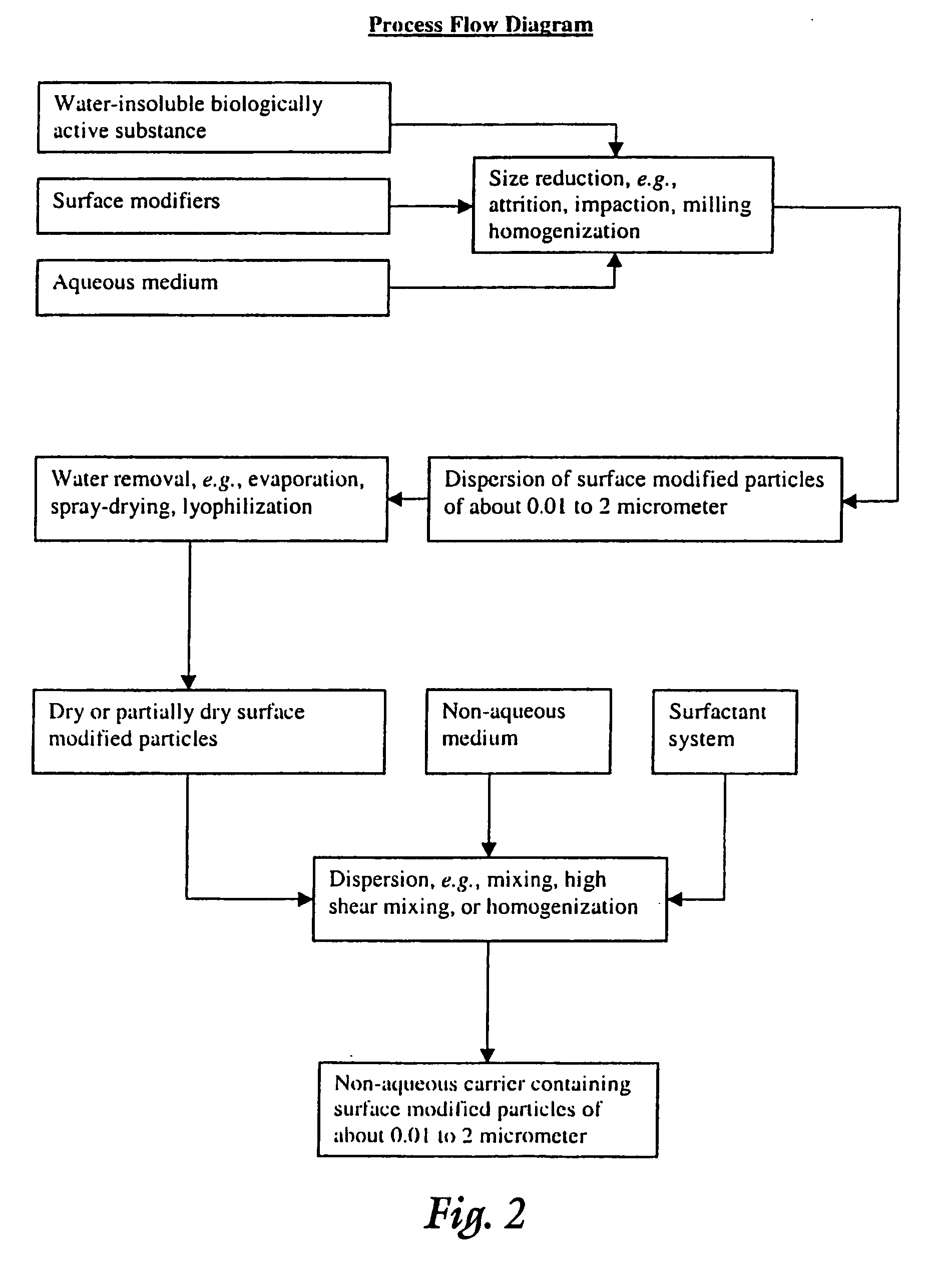Surface modified particulate compositions of biologically active substances
a technology of biologically active substances and modified particles, which is applied in the direction of organic non-active ingredients, peptide/protein ingredients, oil/fat/waxes non-active ingredients, etc., can solve the problem of excessive growth of particle size or irreversible agglomeration, the surface modified particles of water-insoluble drug substances in aqueous suspension may tend to grow over time, and the requirement of removing water from the surface modified particles, etc. problems, to achieve the effect of effective delivery
- Summary
- Abstract
- Description
- Claims
- Application Information
AI Technical Summary
Benefits of technology
Problems solved by technology
Method used
Image
Examples
example i
[0121] Solubility of biologically active substances, particularly drug substances in lipophilic and hydrophilic solvents. The example drug, Itraconazole was found to be very poorly soluble in pharmaceutically acceptable lipophilic vehicles. Itraconazole solubility of at least 25 mg / mL in oil is required for making an oil-in-water type emulsion-formulation. The solvents mentioned in the following table were evaluated. Solubilities, determined by high performance liquid chromatography (HPLC) assay of the dissolved drug in water and several non-aqueous vehicles, are given the following table in units of mg / mL. Low solubility of this drug in either water or organic solvents renders it suitable for formulating as a stable surface modified particulate dispersion in a non-aqueous carrier system.
Solubility of Itraconazole (mg / mL) in some Solvents by HPLCWater0.01Decyl oleate0.02Ethyl oleate0.04Ethyl myristate0.06Isopropyl myristate0.08Ethyl caprate0.10Miglyol-8400.20Soybean oil0.25Miglyol...
example ii
[0122] Solubilization and precipitation behavior of some drugs. As an example, 20 mg of either nifedipine or ursadiol were added into 1 mL of either a medium chain triglyceride, Miglyol 810, or to triacetin, or to benzyl benzoate. Almost all of the nifedipine that was added was observed to remain unsolubilized. Similarly ursodiol was not soluble in either Miglyol 810 or triacetin. This makes it possible to prepare compositions of nifedipine and ursodiol in these non-aqueous media as microparticulate suspension by further particle size reduction.
[0123] However, ursodiol was found to dissolve in benzyl benzoate. A portion of the ursodiol solution in benzyl benzoate was transferred to water and shaken. A mixture containing oily droplets resulted. No precipitation was seen occurring. On examining the mixture by an optical microscope under polarized light conditions surprisingly particles of regular crystalline shape and below 10 micron size were observed. This observation makes it poss...
example iii
[0124] A mixture containing itraconazole and egg-phospholipid in ethyl oleate was subjected to high-pressure homogenization in an Avestin Emulsiflex C5 homogenizer. Homogenizing pressures of up to 20,000 psi were used. The process fluid temperature was maintained at below 40° C. by cooling with a heat exchanger equipped with a jacket of coolant fluid. Fine particulate suspension of volume weighted mean particle size of about 0.6 micron was produced.
PUM
| Property | Measurement | Unit |
|---|---|---|
| size | aaaaa | aaaaa |
| size | aaaaa | aaaaa |
| mean size | aaaaa | aaaaa |
Abstract
Description
Claims
Application Information
 Login to View More
Login to View More - R&D
- Intellectual Property
- Life Sciences
- Materials
- Tech Scout
- Unparalleled Data Quality
- Higher Quality Content
- 60% Fewer Hallucinations
Browse by: Latest US Patents, China's latest patents, Technical Efficacy Thesaurus, Application Domain, Technology Topic, Popular Technical Reports.
© 2025 PatSnap. All rights reserved.Legal|Privacy policy|Modern Slavery Act Transparency Statement|Sitemap|About US| Contact US: help@patsnap.com



